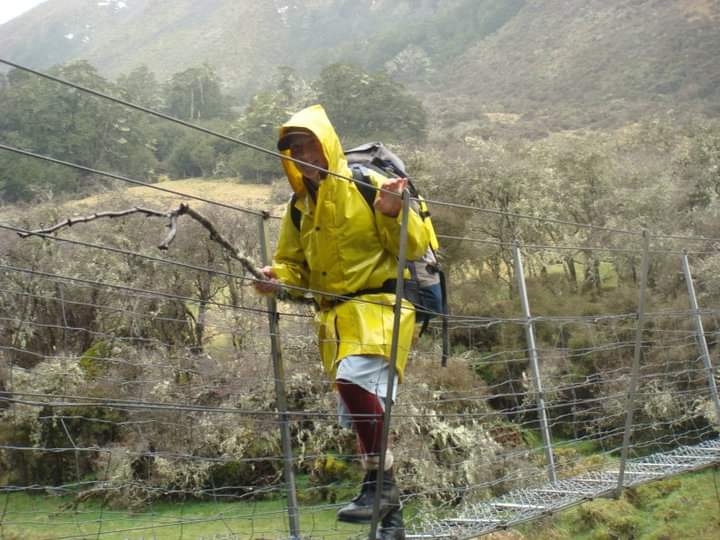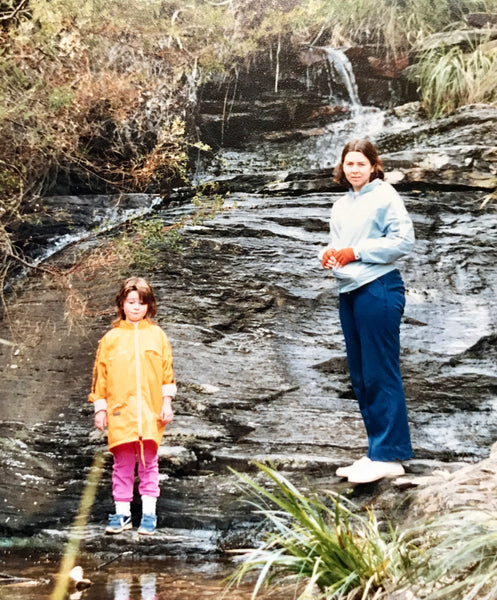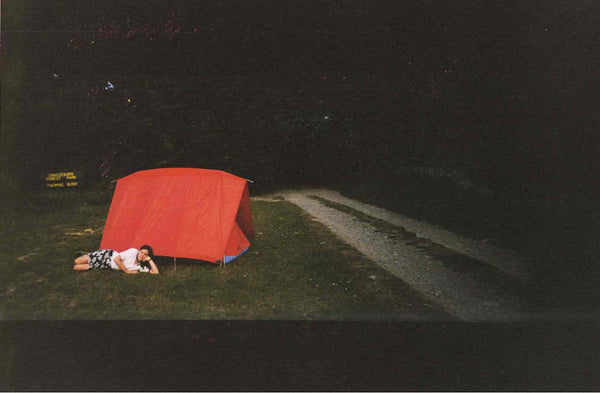How to buy outdoor gear for your child's school camp.

It can be hard to navigate getting outdoor gear for your soon-to-be adventurers, especially when you aren't sure if they'll stick to it. They are also still growing at the speed of light and will outgrow any expensive gear you buy!
And that's where Chelle comes in as our resident Ara Institute: Bachelor of Sustainability and Outdoor Education student (Now Graduated!). She's sharing her tips and tricks for buying gear for kids from personal experience (what her parents did when she was growing up), what she has witnessed from other students during her time in outdoor education and what these outdoor education providers suggest.
As a side note, all the images in this blog are from our staff when they were young and camping - aren't they adorable!? Can you guess who is who?

Let's start with all things jackets and the main advice in this section: A puffer jacket does not replace a waterproof jacket. It's good to have a warm jacket (which can be a puffer) and a rain jacket - they shouldn't be combined to save weight or money.
Here's a great Chelle idea - buy a rain jacket that fits the parent closest in size to the child (or children) then you have one that can fit 2+ people. This is an option if you have a giant on your hands who you'll be looking up to in no time and will outgrow the jacket. Just make sure you get a neutral-coloured one, this way it fits everyone's specific colour tastes.
Regarding warm jackets, a synthetic jacket will be harder wearing and more durable for kids - if they rip a hole, feathers aren't going to be flying everywhere, they're easier to clean and dry, they still keep you warm if wet and tend to be cheaper than their down counterparts.
And a small tip on layering and thermals - go second-hand. There are generally lots of wool and synthetic options at op-shops. They may be in varying states of wear, but ultimately going to keep bodies warm and don't cost a lot. Bigger is also better - you can always roll up sleeves or pants but if they're too small they will restrict movement and make kids less likely to wear them. When we aren't able to be there as parents to tell our kids to put their thermals on or eat their veggies, we need to set them up for success to be independent in keeping themselves warm, dry and fed.

What to do about boots? This will depend on the activity the kids will be doing and what season it's in. If it can be accomplished with a trail running shoe, do that! At least if hiking is not in their future, they can still use the shoes for other things. If you're unsure - ask the teacher/organiser if boots are necessary. If you have to buy hiking boots - don't buy boots that are too big for your kids. They will have a terrible time and then quit hiking long before they can "grow into" them. And make sure you find comfy socks - it will make all the difference.
Tents, Sleeping Bags and Mats.
When looking for a tent, don't worry about it being super lightweight. Always choose hardwearing gear over lightweight gear, especially if it's used by more than one person (or kids). And don't bother with one-occupant tents either - make sure your kiddo has a friend who will share their two-person tent (Most Duke of Edinburgh or other outdoor education program organizers may be able to help set them up with a buddy in this instance if they don't know anyone). It's not just so someone can share the weight (although that helps). For kids, it's also about warmth and safety - if one person leaves the tent at night, two wake up, so someone knows that they come back safely.
A three-season sleeping bag that the whole family can use is the most versatile option when shopping around. If the sleeping bag is too big for shorter or small kids - they can either fold over the end or stuff it with clothes, so they don't have a whole sleeping bag to heat. A sleeping bag liner is super important, especially for down bags, as it means you wash the liner instead of the bag (and you can even get thermal liners if your kids get super cold or are winter camping). If you have younger kids and bed wetting is something to consider, 100% get a synthetic bag (we have a great range of Kelty kids sleeping bags in-store).
There's nothing wrong with using a standard closed-cell cheap foam mat or yoga mat to sleep on - kids don't get neck tweaks like us oldies. If you want to upgrade them in the future, make sure it's to a proper inflating mat, not a self-inflating one (the cheap ones can be bad with over-inflating and random puffy bits). Like everything else, get a size for the tallest person in the household so everyone can share that mat.

Food and Water.
With younger people, there can be a lot of fussiness around food, and when they're out walking all day, they need the energy, so you can't afford to give them meals they won't eat.
A good rule of thumb is don't buy dehydrated or freeze-dried meals unless they've been tested at home first. There's the potential for them not to be rehydrated properly and end up with crunchy dinners or for your kids to hate the flavour/texture.
Alternatives can be those meals in foil packets – pasta, soups etc. And things like crackers, small cans of chickpeas and rice.
Museli Bars, Lollies and chocolate are acceptable, welcomed snacks especially for fussy eaters. Junk food in the outdoors is not a thing (as long as there is a good mix of carbs and other nutritional value foods also being consumed) and having good food we enjoy eating and won't make us feel unwell is especially important for rangatahi, and even more so on first trips out! It can feel pretty hard and at times perhaps even miserable, so giving them a meal or snack to look forward to is one way to brighten the trip up.
We're lucky that some people on Chelle's course (Abby Mitchell and Grace Saywell of Ara Institute's Bachelor of Sustainability and Outdoor Education, Class 725, 2023) created a cookbook of camping meals that are fun, cheap and easy to make - which you can download here. Challenge your kids before they go to the camp to cook you some meals from this over the camping stove so they can practice before they go.

With water treatment, the same try-at-home mentality applies - chlorine tablets are effective and cheap if used well, and your kids don't mind the taste. Other options for filtering your water are the twist onto bottle options, filters that screw directly into your water bladder like the ones from and bottles that already have a filter built in - bonus is they can be shared by the whole family if the chlorine is a no-go.
Get a water bladder - it helps to keep kids hydrated as they can sip away and don't have to stop and get a bottle out of their pack. It's also way less faff - make sure you don't put electrolytes in it, as it will go mouldy (you can get a smaller drink bottle for electrolytes).
The pack chat isn't as long as you think! A daypack with a large capacity is perfect for young people if they don't need a full pack - the 44L Montane Trailblazer is an excellent option. If they need a proper big hiking or tramping pack, make sure you get a one-size-fits-all backpack that isn't for a specific gender. And make sure they don't strap anything to the outside of the pack - it gets caught on everything!
The last thing is; make sure they have a well-stocked personal first aid kit. Don't skimp on the blister plasters - this will make all the difference for comfort and enjoyment! And don't forget painkillers that your kids will take if they need them - sugar-coated or caps etc. Having some Gear Aid patches or tape in there is always good if there is a tent rip or a jacket blow out, that way you can perform emergency repairs if you're a few says away from home.
Here are some resources if you want to learn more or want your kids to learn more:
- Mountain Safety Council has everything from trail guides to FREE online courses filled with all the tramping info you could hope for.
- One of Chelle's tutors, Mike at Ara, has an excellent Youtube channel with informative outdoor education videos.
Written by our awesome shop crew member Chelle Brouwer.
Chelle's Top 5 Tips for Getting Your Child Camp Ready:
1. Make sure you test the food they'll be eating at home first so you'll know they like it and will eat it.
2. Don't get them hiking boots that are too big! They'll go off hiking so fast with blisters, rubbing and all manner of uncomfortable feet well before they grow into the boots!
3. Get a jacket that fits the adult closest in size to the child/children - then you have a jacket that fits 2+ people.
4. Always choose hardwearing gear, over lightweight gear - especially if it's being used by more than one person.
5. A synthetic jacket, instead of a down jacket, is a better option for kids. If it tears there won't be feathers everywhere and it's easier to clean, keeps you warm when wet and tends to be cheaper.










Leave a comment